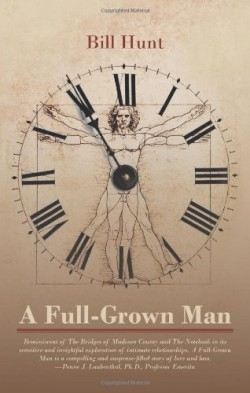
A Full-Grown Man
Ben Bennefield, seventeen-and-a-half, and visual artist Anna Mancini, “almost twenty-five,” are the star-crossed lovers of this romance, Bill Hunt’s second novel. Their older woman—younger man relationship causes a lifetime of emotional upsets for them and their already dysfunctional families.
In the summer of 1951 Ben convinces Anna to consummate the love he has harbored for her since he was twelve and she first came to tiny Gold Dust, Louisiana. They engage in their lovemaking while “thunder sounded again and again, and lightning lit the garden house with quick flashes. And the rain came down.” While the romantic teenager is ecstatic, the realistic Anna warns him, “Go home, Ben, and forget about me, leave me alone.”
Disheartened by Anna’s abrupt departure and lack of further communication, Ben strives to become “a full-grown man” on the family cotton farm with his father, Will, and Hester, his martinet-like mother. Will’s sudden death motivates Hester to demand that Ben forego his education and maintain the farm which prospers and expands over the next few years. Always mindful of Anna, Ben’s hatred for Hester simmers, even when she commits suicide. His animosity intensifies when he discovers flimsy evidence that she may have killed his father. It peaks when finds a cache of money and three letters from Anna, asking him to pursue her even though she has become a famous artist, has married, and travels worldwide. Ben’s quest to achieve manhood brings him bittersweet experiences as a husband, a widower, and a father, while quelling various ghosts and demons from his past.
Many of the scenes between Ben and Anna are poignant, but Hunt’s novel includes a couple of extraneous episodes, such as a cocktail party shooting that interrupts the flow of the narrative. Character development could also be honed to provide more showing and less telling, as with Will and others. The prominence of the aging Gold Dust Bridge as a focal point for the novel is mostly well done, but the quality of the several illustrations throughout the book ranges from good to poor. The portrait of Anna, for one, simply does not do her justice. The attractive cover design will attract potential readers seeking a tale of a conflicted youth. For the most part, they will be satisfied.
Disclosure: This article is not an endorsement, but a review. The publisher of this book provided free copies of the book and paid a small fee to have their book reviewed by a professional reviewer. Foreword Reviews and Clarion Reviews make no guarantee that the publisher will receive a positive review. Foreword Magazine, Inc. is disclosing this in accordance with the Federal Trade Commission’s 16 CFR, Part 255.
